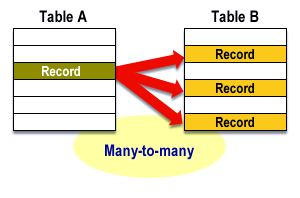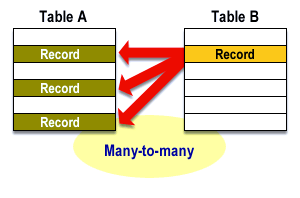| Lesson 8 | Many-to-many Relationships, part 1 |
| Objective | Define many-to-many Relationships. |
Define Many-to-many Relationships
A many-to-many (M:N) relationship exists when, for one instance of entity A, there exists zero, one, or many instances of entity B; and for one instance of entity B, there exists zero, one, or many instances of entity A.
To illustrate such a relationship graphically, think of entities A and B in terms of generic tables. A many-to-many relationship exists when one record in Table A can be associated with many records in Table B; and one record in Table B can be associated with many records in Table A. The following diagrams illustrates an M:N relationship between Tables A and B from the viewpoint first of Table A, then of Table B.
To illustrate such a relationship graphically, think of entities A and B in terms of generic tables. A many-to-many relationship exists when one record in Table A can be associated with many records in Table B; and one record in Table B can be associated with many records in Table A. The following diagrams illustrates an M:N relationship between Tables A and B from the viewpoint first of Table A, then of Table B.


- The diagram above illustrates an M:N relationship between Table A and B from the viewpoint of Table A
- The relationship between Tables A and B from the viewpoint of Table B appears this way.
Many-to-many Relationship in Database
Many to many relationships can only exist while you conceptually design the database and this is when you need to eliminate them.
You physically cannot have it in a working database otherwise your schema would need to change continually.
In the realm of database design and management, the concept of a "many-to-many" relationship presents inherent complexities that are not as pronounced in simpler "one-to-one" or "one-to-many" relationships. This complexity primarily arises from the relational database model's inability to natively accommodate direct many-to-many relationships between two tables. Let's delve into the reasons that make these relationships challenging to handle:
In summary, while many-to-many relationships are a critical aspect of accurately modeling complex data scenarios, their implementation in relational databases introduces additional layers of complexity in terms of schema design, data integrity, query construction, and overall performance management. These challenges necessitate a careful and considered approach to database design and operation.
In the realm of database design and management, the concept of a "many-to-many" relationship presents inherent complexities that are not as pronounced in simpler "one-to-one" or "one-to-many" relationships. This complexity primarily arises from the relational database model's inability to natively accommodate direct many-to-many relationships between two tables. Let's delve into the reasons that make these relationships challenging to handle:
- Direct Representation Limitation: In a relational database, a table is structured to establish relationships between entities through primary and foreign keys. However, a many-to-many relationship implies that multiple records in one table can relate to multiple records in another table. This concept does not directly translate into the relational model's structure, as there is no straightforward way to store these multiple connections within the standard two-table format.
- Requirement of a Junction Table: To effectively implement a many-to-many relationship, it is necessary to introduce an intermediary or junction table. This table includes foreign keys that reference the primary keys of the two tables involved in the relationship. While this solution is effective, it adds an additional layer of complexity to the database schema. The management of this junction table requires extra care, particularly in maintaining data integrity and handling updates, deletions, and insertions.
- Increased Complexity in Querying: Querying across many-to-many relationships is more complex than simpler relationships. It often requires joining three or more tables (including the junction table), which can make query construction more intricate and challenging, especially for those who are less experienced in database querying.
- Data Integrity Challenges: Ensuring data integrity becomes more complex with many-to-many relationships. Actions like updating, deleting, or inserting records require careful handling to maintain consistency across the linked tables. Cascading actions, for example, need to be meticulously planned to avoid unintended data loss or orphan records.
- Performance Concerns: As the size of the database grows, the performance can become an issue, particularly with many-to-many relationships. The need to join multiple tables can lead to slower query performance, especially if the intermediary table grows significantly large. Proper indexing and optimization strategies become crucial to maintain efficient data retrieval times.
- Complications in Database Design and Maintenance: From a design perspective, many-to-many relationships demand a more thorough planning process. Database designers must anticipate the future querying needs and data integrity constraints. Maintenance-wise, these relationships require ongoing attention to ensure that the additional complexity does not lead to data anomalies or performance bottlenecks.
In summary, while many-to-many relationships are a critical aspect of accurately modeling complex data scenarios, their implementation in relational databases introduces additional layers of complexity in terms of schema design, data integrity, query construction, and overall performance management. These challenges necessitate a careful and considered approach to database design and operation.
A many-to-many (M:N) relationship, sometimes called non-specific, is when for one instance of entity A, there are zero, one, or many instances of entity B and for one instance of entity B there are zero, one, or many instances of entity A.
An example is:
An example is:
"employees can be assigned to no more than two projects at the same time; projects must have assigned at least three employees"
Dealing with Many-to-Many Relationships
As you read earlier, there are problems with many-to-many relationships.
1) First Problem: The relational data model cannot handle many-to-many relationships directly and is limited to one-to-one and one-to-many relationships. This means that you must replace the many-to-many relationships that you have identified in your database environment with a collection of one-to-many relationships if you want to be able to use a relational DBMS.
2) Second problem: To understand this problem, consider the relationship between an order a customer places with DistributedNetworks and the merchandise items on the order. There is a many-to-many relationship between the order and the item because each order can be for many items and each item can appear on many orders (typically orders from different customers). Whenever a customer orders an item, the number of copies of the item varies, depending on how many copies the customer needs.
Yes, typically people order only one copy of a movie, but we need to allow them to order as many as they want.
Question: Where should we store the quantity being ordered?
It cannot be part of the order entity because the quantity depends on which item we are talking about. By the same token, the quantity cannot be part of the item entity because the quantity depends on the specific order. This scenario is known as relationship data, which is data that applies to the relationship between two entities rather than to the entities themselves. Relationships, however, cannot have attributes. We therefore must have some entity to represent the relationship between the two, an entity to which the relationship data can belong.
1) First Problem: The relational data model cannot handle many-to-many relationships directly and is limited to one-to-one and one-to-many relationships. This means that you must replace the many-to-many relationships that you have identified in your database environment with a collection of one-to-many relationships if you want to be able to use a relational DBMS.
2) Second problem: To understand this problem, consider the relationship between an order a customer places with DistributedNetworks and the merchandise items on the order. There is a many-to-many relationship between the order and the item because each order can be for many items and each item can appear on many orders (typically orders from different customers). Whenever a customer orders an item, the number of copies of the item varies, depending on how many copies the customer needs.
Yes, typically people order only one copy of a movie, but we need to allow them to order as many as they want.
Question: Where should we store the quantity being ordered?
It cannot be part of the order entity because the quantity depends on which item we are talking about. By the same token, the quantity cannot be part of the item entity because the quantity depends on the specific order. This scenario is known as relationship data, which is data that applies to the relationship between two entities rather than to the entities themselves. Relationships, however, cannot have attributes. We therefore must have some entity to represent the relationship between the two, an entity to which the relationship data can belong.
The next lesson explores many-to-many relationships further.
Ad Database Systems